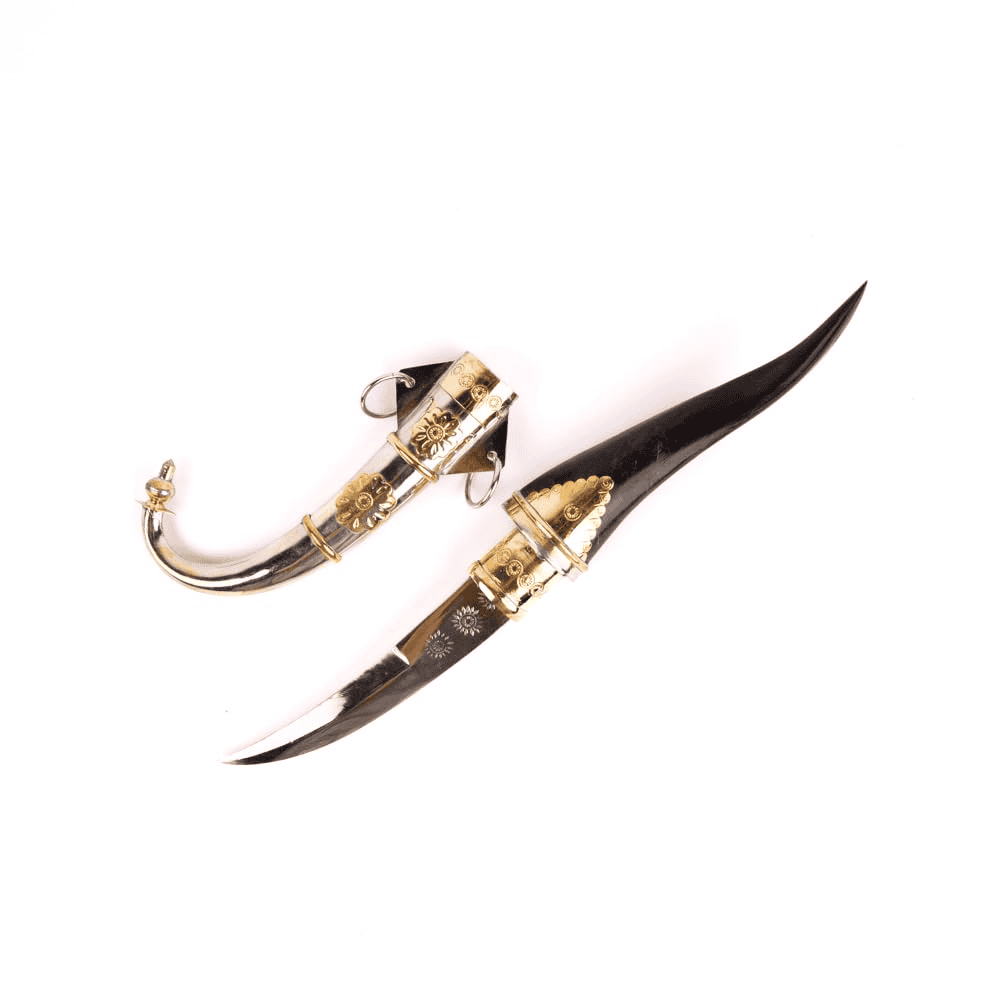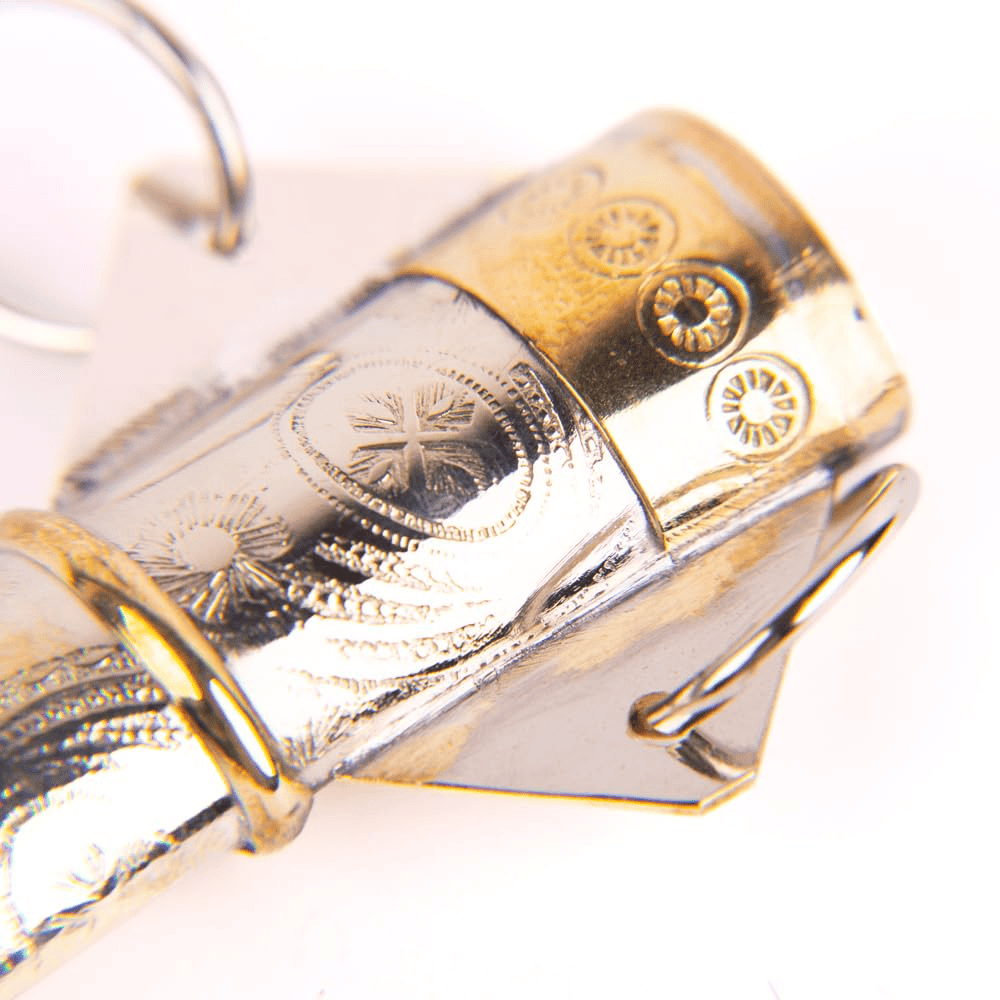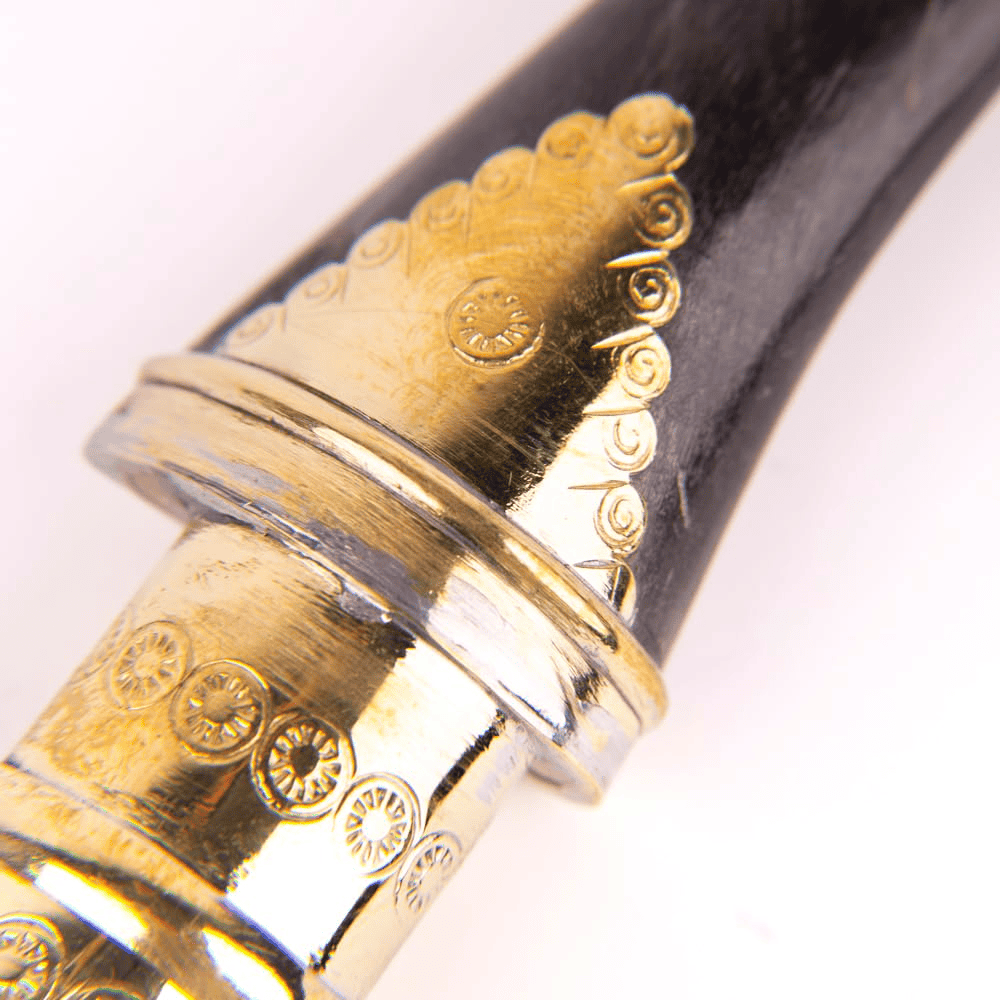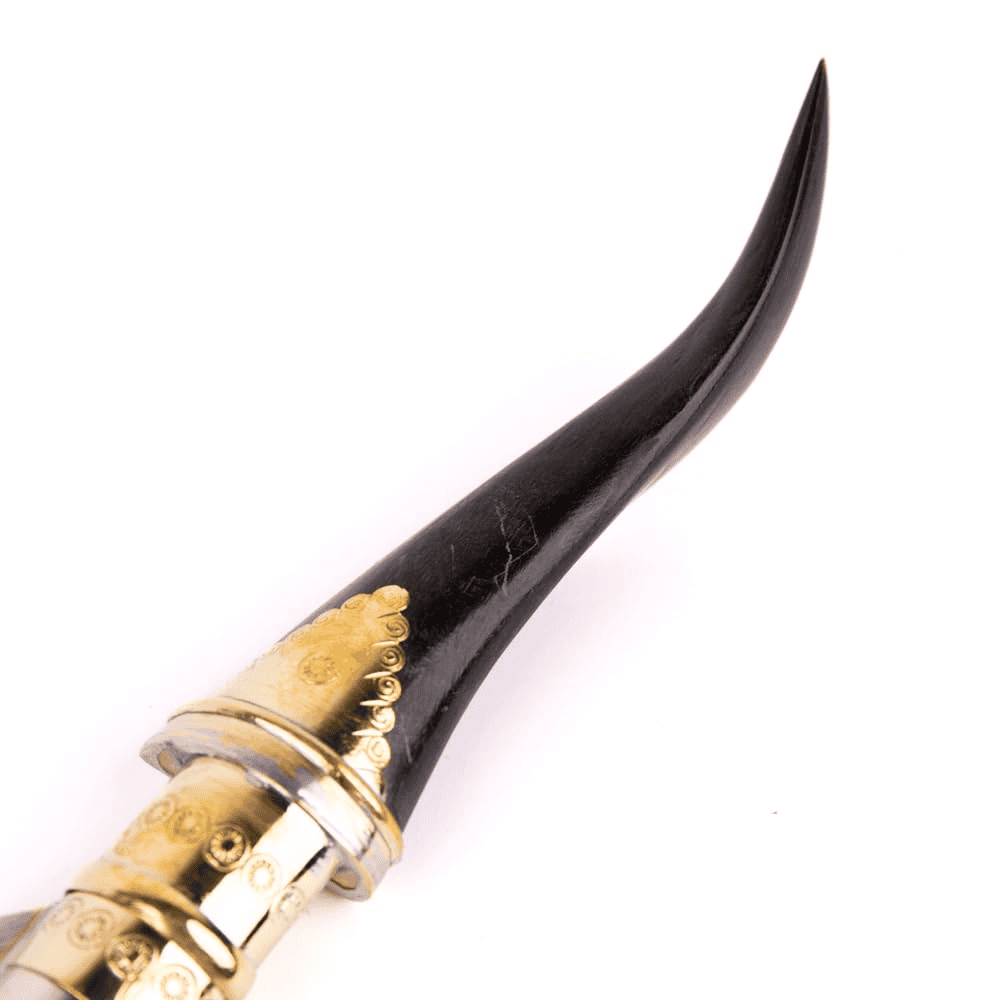What defines the authentic heritage of the Moroccan Koummya dagger?
The Moroccan Koummya, known as the Berber’s traditional dagger, is deeply rooted in North African craftsmanship and tribal identity. Historically worn by the Chleuh people of the Atlas Mountains, this dagger was more than an accessory—it represented prestige, social rank, and belonging. Each piece carries the influence of centuries-old Arabic Jambiya design, blending artistry with practicality. The curves of the blade, the grip of the goat bone handle, and the detailed scabbard combine to preserve Morocco’s cultural essence. The handmade nature ensures each dagger holds slight imperfections, adding authenticity rather than flaw.
Features – Benefits – Advantages (FAB):
- Feature: Traditional Berber-style Koummya dagger.
- Advantage: Represents Moroccan cultural craftsmanship and symbolism.
- Benefit: Offers collectors a genuine piece of Moroccan history.
Bullet Points:
- Inspired by Berber and Arabic Jambiya designs.
- Handcrafted using authentic local methods.
- Symbol of elegance, identity, and heritage.
What materials form the foundation of this handmade Moroccan dagger?
The dagger’s structure merges durability and artistry. The blade is crafted from stainless steel, giving it a sleek, reflective finish resistant to corrosion when properly cared for. The handle, shaped from goat bone, carries a tactile warmth and a rustic texture that modern materials cannot replicate. Every connection point, from hilt to scabbard, is fitted with care by artisans familiar with Moroccan metal and bone work traditions. Slight irregularities in tone or pattern reveal the handcrafting process, distinguishing it from mass-produced replicas.
FAB:
- Feature: Stainless steel blade and natural goat bone handle.
- Advantage: Combines strength with handcrafted artistry.
- Benefit: Provides longevity while retaining authentic, rustic charm.
Bullet Points:
- Blade: corrosion-resistant stainless steel.
- Handle: hand-polished goat bone.
- Authentic imperfections confirm manual craftsmanship.
How is the Koummya dagger designed in size and proportion?
The Koummya’s form balances aesthetics with function. Measuring approximately 27 cm (10.62 in.) in total, the dagger maintains elegant proportions suited for display or traditional wear. The blade length of 11 cm (4.33 in.) ensures compactness, while the hilt’s 15 cm (5.90 in.) grip supports comfortable handling. The scabbard length of 13 cm (5.11 in.) complements the blade snugly, providing protective coverage and visual harmony. The 2 mm blade spine thickness adds just enough rigidity for decorative sharpness without excess weight.
FAB:
- Feature: Compact 27 cm design with balanced dimensions.
- Advantage: Proportioned for display, collection, or traditional attire.
- Benefit: Fits easily in cases or wall mounts without occupying excess space.
Bullet Points:
- Blade length: 11 cm | Handle: 15 cm | Total: 27 cm.
- Ideal for collectors, travelers, and cultural exhibitions.
- Balanced weight for decorative or symbolic use.
Why does the handmade nature enhance its authenticity and character?
Every Moroccan Koummya carries the marks of its maker—slight asymmetry, natural bone grain, or subtle color variation. These are not manufacturing defects but characteristics of genuine handcraft. In Moroccan tradition, handmade objects signify human involvement, patience, and artisanal mastery. The absence of machine uniformity adds soul to the piece. Small imperfections in the blade or handle testify to its authenticity, ensuring no two daggers are identical. This individuality makes each dagger an original collectible rather than a duplicate product.
FAB:
- Feature: Fully handmade by Moroccan artisans.
- Advantage: Each dagger has unique visual and textural identity.
- Benefit: Collectors receive a singular, non-replicable artifact.
Bullet Points:
- Handmade imperfections are intentional and valued.
- No two Koummyas share identical form or pattern.
- Represents the personal touch of Moroccan craftsmanship.
How should this dagger be cared for and maintained?
Though crafted from stainless steel, proper maintenance extends its life and appearance. Occasional light oiling of the blade prevents oxidation, especially in humid environments. The goat bone handle benefits from gentle polishing using a dry cloth, preserving its smooth sheen. Avoid prolonged exposure to moisture or extreme temperatures to protect both metal and organic materials. Display pieces should be stored in dry, shaded environments to maintain the natural coloration of the handle and scabbard.
FAB:
- Feature: Requires minimal yet specific maintenance.
- Advantage: Preserves natural bone color and metal integrity.
- Benefit: Ensures long-term preservation of handmade quality.
Bullet Points:
- Use light oil on the blade periodically.
- Keep dry and avoid moisture exposure.
- Clean goat bone handle gently without chemicals.
What makes the Koummya a collectible and decorative piece?
Collectors value the Moroccan Koummya for its aesthetic and cultural resonance. Its curved blade, black handle, and yellow details make it visually distinct from generic daggers. Displaying it on a wall, shelf, or in a glass case instantly adds exotic character and historical context. Beyond decoration, it connects the space with Morocco’s rich Berber and Islamic artistic influence. The dagger’s symmetry and craftsmanship appeal to enthusiasts of ethnographic and Oriental art collections.
FAB:
- Feature: Distinctive black-and-yellow design with ornate curvature.
- Advantage: Functions as an elegant display object.
- Benefit: Adds cultural depth to interior spaces or themed collections.
Bullet Points:
- Decorative addition for collectors or art enthusiasts.
- Fits Oriental or cultural décor settings.
- Represents Moroccan metalwork artistry.
How does the Koummya connect to traditional Moroccan dress and identity?
Historically, the Koummya was not merely ornamental—it was a component of traditional attire. Worn at the waist with the tip of the scabbard forward, it signified dignity, readiness, and belonging. Men from the Atlas region traditionally wore it during ceremonies or public appearances as a sign of pride. Even today, it continues to represent cultural continuity and Berber identity. The dagger serves as a visual link between Moroccan fashion, status, and ancestral pride.
FAB:
- Feature: Traditional waist accessory among Berber men.
- Advantage: Symbol of status and community recognition.
- Benefit: Allows modern owners to preserve and respect ancient customs.
Bullet Points:
- Integral to Moroccan ceremonial dress.
- Worn at waist with distinctive positioning.
- Embodies identity and cultural lineage.
How does the craftsmanship of the Koummya reflect Moroccan metalwork traditions?
Morocco’s metal artisans combine functionality with intricate artistry. The Koummya dagger follows this principle, blending polished stainless steel with engraved detailing. The curves of the blade mirror ancient Arabian Jambiya influences, yet maintain Moroccan distinctions through shape and ornamentation. The balance between metal and bone reveals precision—no element feels excessive or overlooked. This craftsmanship style continues a legacy that values patience and mastery over mechanized uniformity.
FAB:
- Feature: Detailed Moroccan metalwork and bone integration.
- Advantage: Embodies centuries of metal artistry in compact form.
- Benefit: Provides buyers with a decorative item steeped in traditional skills.
Bullet Points:
- Reflects Berber and Arab artisanal synthesis.
- Combines durability with ornate detailing.
- Symbol of Morocco’s enduring craftsmanship.
How suitable is this dagger for collectors, decorators, and cultural enthusiasts?
This small Koummya appeals to multiple audiences. Collectors appreciate it for its authenticity and handmade origin; decorators value its visual elegance and cultural story. For cultural enthusiasts or educators, it serves as a tangible teaching artifact about North African heritage. Whether displayed in a study, gallery, or living space, its modest size and traditional craftsmanship make it a versatile addition that complements historical or artisan-themed interiors.
FAB:
- Feature: Compact size and versatile display potential.
- Advantage: Fits easily in collections or exhibitions.
- Benefit: Adds historical and aesthetic context to personal spaces.
Bullet Points:
- Ideal for collectors and cultural presentations.
- Authentic handmade origin for verified heritage.
- Lightweight and easy to mount or display.
What should be expected from natural imperfections and color variations?
Each dagger bears subtle variations in color and texture, particularly in the goat bone handle and metal finish. These natural differences come from the material’s organic nature and manual crafting process. Slight rust or color irregularities are typical and not considered damage. Instead, they indicate authenticity and age, giving the piece its unique personality. Collectors value these irregularities as markers of originality, confirming the dagger’s handmade nature.








Reviews
There are no reviews yet.